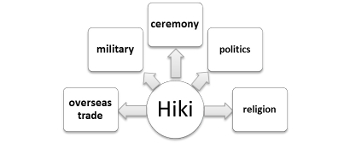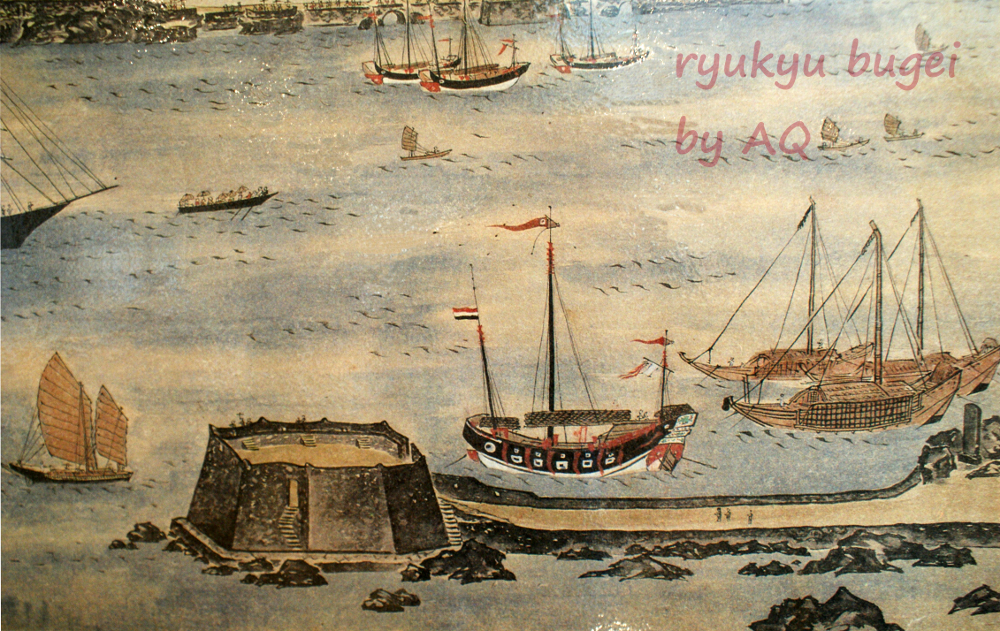Names and DOB
- Childhood name: Masanrā 眞三郎
- Chinese-style name: Ma Jishō 麻時嘗
- Born: as the firstborn son, 1513
Family
- Father: Shinmō 眞孟
- Mother: A person from Izumisaki village
- Wife: Manabi 眞鍋, daughter of Oroku Pēchin Sōshin 小禄親雲上宗親 of the Sō-clan 莊氏 (she died 1613-08-14. Posthumous name: Getsuho 月蒲)
- Oldest son: Ōmine Pēchin 大嶺親雲上
- Second son: Gima Niya 儀間爾也
- Oldest daughter: Umitama 思玉 (date of birth and death unknown, married Heianzan Pēchin Yūmei 平安山親雲上重明 of the Tsu-clan 兪氏)
- Third son Shinjō 眞常
Chronology
During the Era of King Shō Sei 尚清王
- 1546-08-10: Served as adjudant (Chikudun) of the Sejiaratomi 勢治荒富筑登之, sailing towards the countries of South-East-Asia (nanban 南蠻)
Note: Nanban 南蠻 or “Southern Barbarians” usually refers to the Europeans – Spaniards and Portuguese – who came to Japan in the 16th and 17th centuries via Southeast Asia. However, from the Muromachi‑ (1336–) to the early Edo-era (1603–) it referred to the countries of South-East-Asia.
- 1550-10-08: At the time when tribute chief-envoy Mai Shishi 邁志刺 sailed to Fujian 閩, he served as a warehouse manager (Kansha 官舎). After his return to Ryūkyū he was appointed Estate steward (Jitō 地頭) of Sesoko in Nakijin district 今歸仁間切瀬底, and appointed commander (Seitō) of the Sejiaratomi 勢治荒富勢頭
- 1555-01-10: He accompanied the envoys Ryō Ken 梁顯 and Ba Chushō 馬忠章 to Fujian to present tribute to the Chinese Emperor
During the Era of King Shō Gen 尚元王
- 1560-08-08: Transferred to the office of Estate steward (Jitō 地頭) of Ōmine in Tomigusuku district 豊見城間切大嶺
- 1562-02-25: Together with the “To-tsūji” Ryō San梁燦, he sailed to Fujian to inquire about the return of the “ship of the heavenly envoys” (=Sappōshi) to China
Note: To-tsūji 都通事: mainly, but not limited to, senior interpreter-clerks who handled tributary and other public affairs
- 1562-12-05: Appointed commander (Seitō) of the Fusaitomi 相應富勢頭
- 1563-11-05: Again appointed commander (Seitō) of the Sejiaratomi 勢治荒富勢頭. Afterwards, as a reward for his loyalty during various trips, he was conferred to the court rank of Zashiki (rank 4 minor) 座敷. Finally he succeeded his father as the head of household and assumed office as Estate steward (Jitō 地頭) of Gima in Mawashi district 眞和志儀間
- 1595-10-09: Died after a long life of 83 years. Posthumous name: Shō’ō 松翁
Additional Info
The Nature of the Hiki
Each Hiki was referred to by a unique name, for instance Fusaitomi, Sejiaratomi, Seiyaritomi etc. As we can see from the genealogy above, Gima Pēchin Shinmei was first appointed Chikudun (adjudant), and later promoted to Seitō (commander) of a Hiki.
The original nature of the Hiki is connected to the eulogistic suffix ~tomi. This suffix is a shortened form of its original meaning, that is: to become famous or renowned, to achieve fame. In old Ryūkyū it was used as a eulogistic suffix for large seagoing vessels: All the Hiki names bear such ship names and the eulogistic suffix, too. That is why it is said in the above genealogy that Gima Pēchin Shinmei “served as Chikudun of the Sejiaratomi, sailing towards the countries of South-East-Asia.” This can also be seen in the oldest known written appointment of royal office (jireisho 辞令書) in existence, dated 1523-08-28:
“The statement below is an order of the king. Shiotarumoi, who belongs to the Seiyaritomi Hiki, is appointed to the post of warehouse manager aboard the Takara-maru, which will soon set sail for China. This writ of appointment is given from the king to the above-mentioned Shiotarumoi.”
The suffix ~tomi designating a ship-name also often appears in the collection of ancient prose called Omoro-sōshi, for example in the Kakuratoyotega-bushi from Omoro-sōshi Vol. 3. In this Omoro appear the terms Yohikitomi, Sejiaratomi, Yotsugitomi, Kumokotomi, Amaetomi, and Oshiaketomi, which were all names of Ryūkyūan seagoing vessels.
Maritime-based and Land-based Hiki

The Hiki as an organic combination of various government functions. By Andreas Quast.
Iha Fuyū stated, “Because foreign trade voyages were at the center of the activities of the people of Old Ryūkyū, we realize that the Sentō (captains) steering these vessels were diverted from their original intended use.” Indeed, the designations of seagoing vessels and their associated official posts coincide with that of the land-based Hiki. Consequently, the land-based Hiki had the same standardized office organization as the organization of the sea-going vessels. From that, Takara formulated the question that, perhaps, the Hiki were “land-based maritime vessels” (Chijō no kaisen 地上の海船), and the vessels were “Hiki floating on the sea” (Umi ni ukanda Hiki 海に浮んだヒキ). Just as sea-going vessels would sail in a fleet comprising of several ships, the Hiki were also organized in groups consisting of a number of Hiki. And just as the ship with the chief tribute envoy as its commander was the flagship of a fleet, the Hiki with its Hikigashira as commander was the “flagship” in each of the Three Guards.

The Hiki as a maritime and land-based organization. By Andreas Quast.
At the time this system emerged, the king was on top of the country’s official overseas trade, which was solely managed by the royal government, and therefore, the envoys’ ships were government-owned ships. All posts in this official overseas traffic were also issued in the name of the king, as is clearly shown in the kingdom’s written appointments (jireisho), and thus all crew members were employees of the royal government. In this way, all activities in the country of destination were government businesses, too. And so, regardless of being sailing voyages or land-based duties, any of the activities the Hiki were involved in were government businesses. This was the state of affairs, and it was this framework that the system of the Hiki originated in.

Yarazamori-gusuku. Photo by Andreas Quast. Excerpt from a picture painted by Tomoyose Chikudun Pechin Kikō 友寄筑登之親雲喜恒, 116.5 x 56.5 cm. From the possession of the Okinawa-kenritsu Zushokan Higaonna Bunko 東恩納文庫.
Sources
- 沖縄の歴史情報 第5巻。画像と全文テキストデータベース (Ⅰ)。 (6)「琉球家譜」の情報化。①首里系家譜。麻姓家譜 (田名家).
- Naha-shi Shi. Shiryō-hen, Dai Ni Maki, Chū no 7. Naha no Minzoku. 那覇市史。資料篇 第2巻,中の7。那覇の民俗。
- Takara Kurayoshi, 1993
- Ryūkyū-kuni Yuraiki, 1713
- Iha Fuyū, 1975
- Okamoto, in: Acta Asiatica 2008
- Quast, Andreas: Karate 1.0 (2013)
- Others
© 2017 – 2022, Andreas Quast. All rights reserved.
